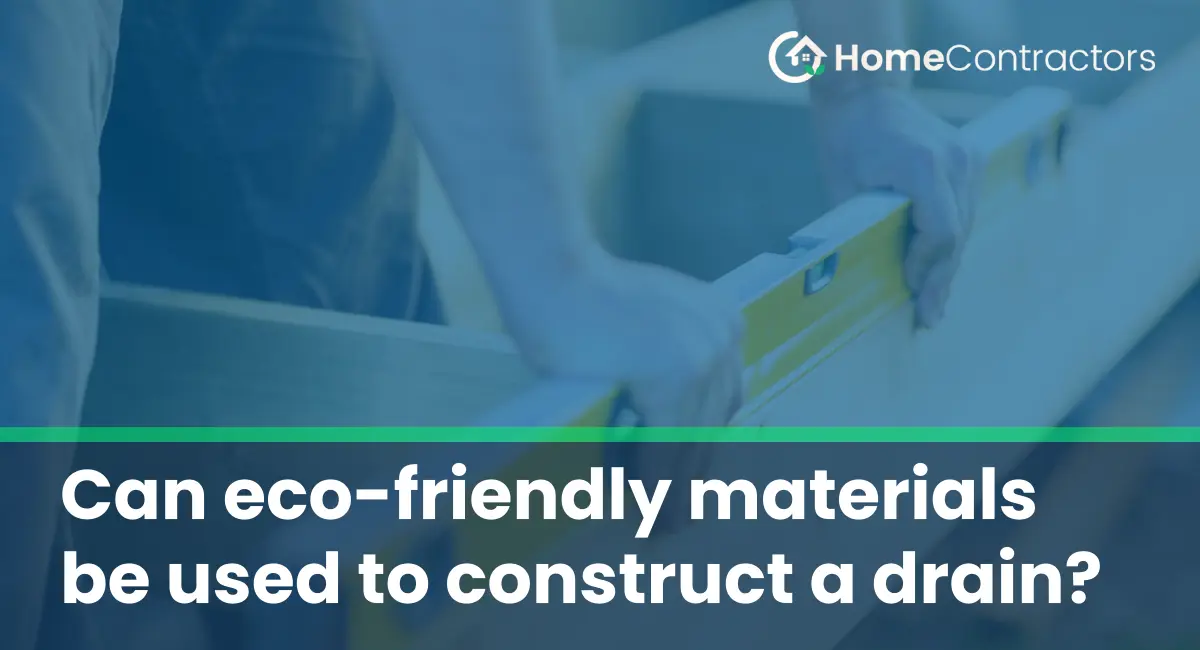In today’s world, sustainability has become a crucial factor in all areas of life, including construction. As the global focus shifts towards reducing carbon footprints and finding eco-friendly alternatives, it is essential to explore whether eco-friendly materials can be used to construct drains. Drains play a vital role in managing stormwater runoff and wastewater disposal, and by incorporating environmentally friendly materials into their construction, we can contribute to preserving our planet’s resources and minimizing environmental impact. In this article, we will delve into this topic, exploring different eco-friendly materials that can be used for drains and their potential benefits.
Eco-friendly materials for drain construction
1. Recycled Steel
Utilizing recycled steel for drain construction is an effective way to reduce the demand for raw materials and minimize the carbon footprint. Recycled steel, sourced from scrapped vehicles or demolished structures, is durable and can withstand the pressures and corrosive elements in drain systems. Additionally, it reduces the need for new steel production, which requires significant energy consumption and produces greenhouse gas emissions.
2. Porous Concrete
Porous concrete provides an eco-friendly alternative to conventional concrete used in drain infrastructure. Its unique composition allows water to flow through its surface, effectively reducing stormwater runoff. By installing porous concrete drains, not only do we help mitigate flooding risks, but we also alleviate the burden on sewer systems, which can become overwhelmed during heavy rainfall events.
3. Recycled Plastic
Plastic waste is a growing environmental concern, with millions of tons ending up in landfills and oceans each year. Repurposing recycled plastic for drain construction is an innovative solution to address this issue. Recycled plastic drains are durable, resistant to corrosion, and light in weight. Additionally, using recycled plastic helps reduce the energy consumption and greenhouse gas emissions associated with producing virgin plastic.
4. Fiberglass Reinforced Plastic (FRP)
Fiberglass reinforced plastic is another eco-friendly material choice for drain construction. FRP utilizes a combination of plastic and glass fiber, resulting in a strong and lightweight material. Its resistance to corrosion and ability to withstand harsh weather conditions make it an ideal choice for drains. Furthermore, FRP is highly durable, offering a long lifespan and reducing the need for frequent replacements.
Benefits of eco-friendly materials for drain construction
1. Reduction in resource consumption
By incorporating eco-friendly materials into drain construction, we can reduce the demand for virgin resources, such as steel or concrete. This reduction in resource consumption helps preserve our planet’s natural resources and minimize deforestation and mining activities associated with traditional drain materials.
2. Lower carbon footprint
The production of traditional drain materials, such as concrete and steel, consumes large amounts of energy and releases significant greenhouse gas emissions. Using eco-friendly materials like recycled steel, porous concrete, or recycled plastic can significantly lower the carbon footprint associated with drain construction.
3. Improved water management
Eco-friendly drain materials, like porous concrete, allow water to permeate and recharge local aquifers, thus replenishing groundwater resources. This feature helps prevent water scarcity and creates a sustainable water management system. Additionally, with efficient stormwater management, the risk of floods and waterlogging is reduced, benefiting both urban and rural areas.
4. Extended lifespan and reduced maintenance
Many eco-friendly drain materials, such as recycled plastic or FRP, offer increased durability compared to traditional materials. They are resistant to corrosion, deterioration, and wear, resulting in a longer lifespan. This longevity reduces the need for frequent maintenance and replacement, ultimately saving costs and minimizing environmental disruption.
Eco-friendly materials can undoubtedly be used to construct drains. Incorporating recycled steel, porous concrete, recycled plastic, or fiberglass reinforced plastic into drain infrastructure offers numerous benefits, including reduced resource consumption, a lower carbon footprint, improved water management, and extended lifespan with reduced maintenance requirements. By selecting eco-friendly materials for drain construction, we take a step towards a more sustainable future, minimizing our impact on the environment while efficiently managing stormwater and wastewater disposal.
